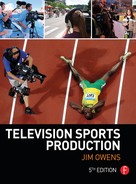Chapter 8
Lighting
A famous architect once said: “Without light there is no architecture.” We can say the same for television: “Without light there are no pictures.” The challenge is to make the lighting produce natural three-dimensional visual sensations of the action at any position on the field of play. I know my job is done when the pictures look fantastic and nobody mentions the lighting.
David Lewis, Lighting Director for television sports
As mentioned in the previous chapter, lighting is one of the primary considerations when determining camera placement. Cameras need a basic level of light to operate. In addition, the creative aspects of lighting can help distinguish the athletes from the field of play and help set the mood of the production. Below is a review of some of the issues that need to be considered for indoor and outdoor venues.
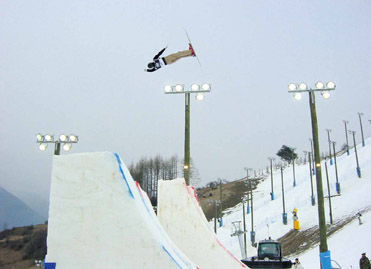
Figure 8.1
Sometimes lighting is used to boost the little light that is available.
Indoor Venue
- Does the venue have adequate lighting or are additional lights required?
- Will the heat generated by the lighting instruments be too much to handle for the air conditioning system in the venue?
Outdoor Venue
- Will the event be shot during daylight or at night (see Figure 8.1)?
- What kind of lighting is already available?
- Where will the sun be located during the production?
- Does lighting need to be added to illuminate dark shadows on the field of play? It is important to view the venue at the same time of day you will be shooting the event in order to correctly evaluate the lighting conditions.
Other Lighting Concerns
- Can the electrical system handle additional lights? If the venue lights are turned on at night, can the electrical system handle the increased load of a mobile unit/OB van? Is anything else using your electrical circuit?
- Does talent require special lighting? If so, where does special lighting for the talent need to be located (booth, field, mixed zone, etc.)?
- Can lights be hung on existing structures?
- Can windows be covered or filtered in order to block out daylight or reduce glare?
Most professional sports venues have special lighting specifications. For example, the International Olympic Committee Broadcasting Guide specifies the following:
In general, the lighting level should not be less than 1400 lux measured in the direction of the main television cameras. Special care must be taken to match color temperature in the case of venues where there is a mix of artificial light and daylight. Additionally, at indoor venues where windows and translucent roofs may cause daylight interference, this problem must be addressed to prevent negative effects.
Many sports organizations or federations have specific broadcast lighting standards for stadiums. The NCAA is no different. The NCAA lighting standards vary based on the size of the venue and the specific sports being broadcast. Here is an abbreviated version of some of their guidelines:
Basketball: Color temperature of 3,600 degrees Kelvin and a minimum color rendering index of 65. Field houses that seat approximately 10,000 spectators, require 125 foot-candles per square foot. NBA arenas with seating capacities of 15,000 to 20,000 need 200 foot-candles of light and domed stadiums with seating for up to 70,000 require 250 foot-candles of light.
Football: Regional television broadcasts require 75 foot-candles, national broadcasts must be lit with 100 foot-candles, and championship games require 125 foot-candles of light.
Hockey: Standard and televised college hockey games are illuminated by 100 foot-candles. Division I’s Frozen Four and championships of lower divisions must have 125 foot-candles of lighting.
Lacrosse and Soccer: 75 foot-candles for a regional broadcast, 100 for a national broadcast, and 125 for the championships.
Baseball and Softball: Regionally and nationally broadcast games need 100 foot-candles of lighting for the base paths and 70 for the outfield grass. During the championship rounds, fields need 125 foot-candles in the infield and 100 in the outfield.
Wrestling, Boxing, and Volleyball: 80 foot-candles for all standard and regional broadcasts, 100 for national broadcasts, and 125 for championships.
Swimming and Water Polo: 75 foot-candles for regional broadcasts, 100 for national broadcasts, and 125 for the championships.
Track and Field: For regional broadcasts, both parts of the stadium need 75 foot-candles. Facilities require 100 foot-candles of lighting for national broadcasts and 125 for the championships.
Tennis: 75 foot-candles of light for regional broadcasts of matches, 100 foot-candles for national broadcasts, and 125 for NCAA championships.
Field of Play Lighting Requirements (Sydney Olympic Venues)
- Light level. Field of play (FOP) should be 1,400 lux (130 fc). Some sports, particularly martial arts, require a minimum of 2,000 lux (185 fc).
- Uniformities. Lighting must be uniform to ensure balanced and even illumination of the FOP.
- Modeling. Lighting must ensure good modeling and natural-looking scenes.
- Panning. The lighting has been designed to ensure smooth illumination over the breadth of the action during panning.
- Replays. Mindful of the ever-increasing use of replays in production, areas on the FOP have been identified that will probably be the focus of highlights and replays. Definitive quantitative tolerances have been set for the quality of the lighting in these zones.
- Spectators. The contrast between the foreground and background has been specified for picture composition and to capture the emotion of the crowd.
- Glare. Stringent guidelines have been designed to control glare and spill light to ensure minimal lens flare while keeping athletes happy.
- Super slow motion. Higher light levels have been requested in SSM areas. A plan has been devised to reduce the usual flicker effects of AC-supplied lighting equipment when captured by slow-motion cameras.
Olympic Production Guidelines
Lighting a large sports facility is incredibly time-consuming. Here are the steps.
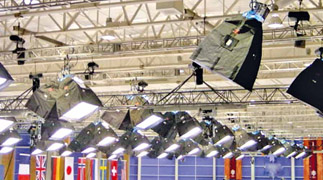
The lighting director must work with directors and producers to determine key camera locations. For example, in swimming, 70 percent of the television production usually comes from the rail cam that runs along the side of the pool. Since the rail cam is the key production camera for swimming, the lighting crew needs to especially focus on that camera when determining light levels and the reduction of reflections and glare. Once the key camera area is lit as well as possible, then lighting has to be adjusted for the remaining cameras.
Once the detailed specifications have been created, the specifications have to be explained and sold to the venue management, the sports federations, and the various managers that will deal with lighting. This is not always an easy task since these people are not always knowledgeable about television production processes and requirements. Once the specifications have been approved, a venue lighting plan is created that meets the list of specifications. The positioning of each light is critical due to each specific camera’s angle of view.
After the lights have been installed, it is important to verify that the lighting meets the specifications. Each camera shot needs to be reviewed on a video monitor, using game time camera positions. Lights can then be fine-tuned to maximize the quality of the image.
Outside venues have their own specific problems. For example, it is important to know where the sun will be during the event, where the shadows will be, and what reflections are created.
The challenge is to make the lighting produce a natural three-dimensional view of the action on the position on the field of play.
Lighting the Night: An Interview with David Lewis
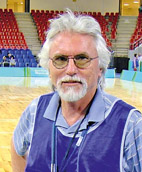
Lighting director David Lewis has developed lighting plans for three Olympics, as well as other sports events around the world. We talked to him about the challenges of lighting at night.
How are outdoor night venues different from indoor venues?
Indoor venues make it easier to get an overall consistent light. Light bounces off of the ceiling and the walls. With all of that bounce, the lighting is more uniform. Indoor, the contrast is relatively easier to create with the building interior surfaces. Outdoor venues, on the other hand, are difficult to light. There is nothing on the sides to bounce the light off. That means that we deal with more shadows. Another problem with lighting the outdoor venues at night is that we don’t want the images to show the field of play lit with everything around it black. The contrast can be severe. This means that we have to light the background and people to create more of an ambience. This requires more beauty or decorative lighting than we would normally do for sports. We also have to be much more careful of where we place our lights. We don’t want athletes or the cameras to be “blinded by headlights” during the competition. That means that the positioning of our lights is very critical (see Figure 8.2).
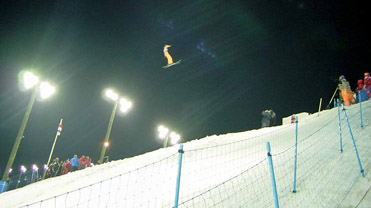
Figure 8.2
Lights must also be kept high in order to give smoother lighting across the field of play.

Figure 8.3
Lighting must be kept out of the athlete’s eyes and the camera lens.
What are some of the lighting challenges?
It used to be that a lot of lighting was needed. However, the latest cameras are much more sensitive to light. The big difference is the need for smoother lighting across the venue. One of today’s difficulties is that camera’s film-like quality is unforgiving; it shows every change in lighting. That means that there can be no compromise on lighting (see Figure 8.3).
Lighting an Olympic venue is difficult enough as it is. Lighting an outdoor venue at night has prompted David to emphasize his motto “Not more light but better light.”
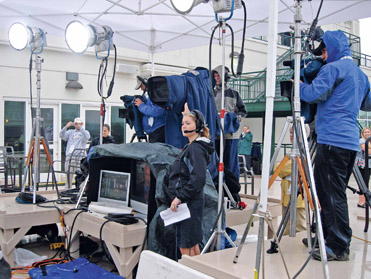
Lighting a commentators’ broadcast area takes an enormous amount of work. Lighting Design Group (LDG) has worked on five Olympics, lighting NBC’s sports commentators. Lighting designer Steven Brill described the lighting process in five stages: preproduction, preproduction implementation, hang and focus, rehearsals, and, finally, the production. Throughout the entire process, LDG’s staff work with NBC’s producers, directors, senior management, production designer, talent, make-up/hair, and video operator. Each one participates in the process from their unique angles.
The preproduction phase includes logistics and design. Logistics operations include determining how many locations, where the locations are geographically, how many talent are used at each location, what is the background, where the available power is, and what the time frame is. A significant issue is whether the location is interior or exterior.
The majority of the preproduction phase is actually in lighting design. LDG works closely with NBC’s production designer and NBC production to establish the look that is needed. The goal is to create a concept that fits the event, using texture and color. It is also important to know who the talent is going to be at each location since different people require different lighting.
The second stage is preproduction implementation. In this phase, LDG works to obtain all of the equipment that will be needed, which includes lighting instruments, grip gear, perishables, patterns, and spare lamps. LDG uses theatrical types of instruments (ellipsoidal, softlights, and freznels) since they bring out the texture in the background. Outdoor venues primarily use HMI since they are brighter and balanced. NBC’s sets utilize light boxes (background scenery photos) with fluorescent lights. LEDs and fiber optics are used as edge lights for glass and furniture. Fiber is used to enhance sets as tiny point lights that add sparkle.
The third stage of lighting is hang and focus. This is the phase where all lights are hung on the grid and positioned as shown on the lighting plot. Gels and patterns are also put in place.
Rehearsals occur in the fourth stage of the lighting process. Now that the lights have been hung and are positioned, the director actually looks at the lights on camera. As each camera shot is examined, the lighting is modified to improve the image. After the director is satisfied with the lighting, the talent is brought in to make sure that they look good. Again, modifications will be made all along the way.
The final stage of the lighting process is the production phase, where, mixed with cameras, microphones, and an incredible crew, the show is broadcast (see Figure 8.4).

Figure 8.4
Lights may be positioned in the commentators’ area for stand-ups so that the talent’s lighting will be the same as the field of play lighting.
